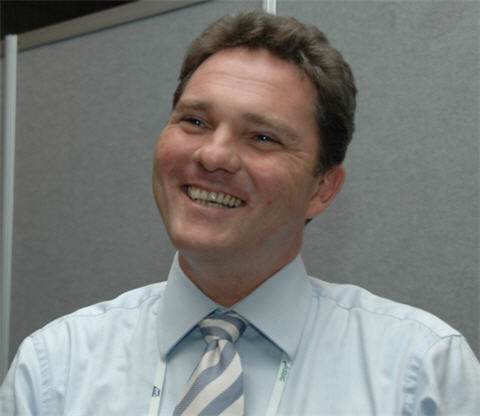SAP aims A1S on demand solution for 2008

SAP's been working three years on developing a new business application suite and business model. Code-named A1S, the suite is aimed at the lower end of the mid-sized company segment, which is comprised of about 1 million companies. It's part of SAP's goal to grow from 39,000 customers to 100,000 by 2010, according to Hans-Peter Klaey (pictured below), president of Global SME for SAP (See Dennis Howlett's post on our meeting with Klaey). For context, he sized the large enterprise market at 20,000, upper mid-size at 60,000, and small business at 55 million.
"We are adding 6,000 customers per year, so every 55 minutes we have a new customer, Klaey said. "We need to accelerate that by three to four times to come to number."
At this point, SAP is still being coy about precisely what A1S is going to be when it grows up. It's based on enterprise service architecture and will be first delivered as an on-demand service, Klaey said during an interview. Given A1S's heritage, it will have a strong underlying SOA foundation. Customers don't care about the engine, just whether is works in a way that fits their business and workflow. It's success will be closely tied to usability, configurability and pricing. A1S will have its share of Web 2.0 features and mashup capabilities.

SAP has been showing the product to beta customers since March, Klaey said, with over 150 firms checking it out.
Klaey explained the positioning and go-to-market strategy for the suite. SAP is investing $300 to $400 million in bring the suite to market, mostly on service, support and marketing, Klaey said. He said SAP is working in three different areas to make the 100,000 customer number--the product porfolio; service, support and consumption (product distribution); and go-to-market strategy.
Besides the phantom A1S, SAP's SME product portfolio includes All-in-One (A1), aimed at the upper mid-market, with a deep industry and micro-vertical focus, and Business One (B1), which is aimed at the pool of 55 million small businesses.
Service and support for A1S cannot be a high cost to customers, and the on demand consumption model will allow customers to pay for only what components they use, on a subscription basis, Klaey said.
Klaey compared A1S to an off-the-rack suit, which allows for some customization, but not comparable A1, which is more like a hand-tailored suit that can be composed out of many kinds of fabrics and styles.
However, A1S won't be generic, Klaey said, and will have some industry flavors, but limited to manufacturing, service and trade businesses at the beginning. With an on demand model, the suite can more readily incorporate new functionality and get customers up and running. He also allowed that A1S will be more than a suite, but also a platform with exposed Web services that supports mashups and an ecosystem of add-ons, similar to salesforce.com's AppExchange.
The go-to-market strategy is new for SAP, using the Web, telemarketing, indirect partners, its own salesforce and indirect salesforces to sell. "You do not go from a sales-push model, you need a buy-pull model. It can only be Web-based, and you have to make sure you get on short list of this type of company," Klaey said. As part of the new marketing strategy, SAP will offer A1s on a try-before-you-buy basis.
Speaking at Sapphire, SAP Chairman and Chief Software Advisor Hasso Plattner envisioned software that customers play with before they sign a contract, and once there is a real project, the customer comes up with a snapshot of forms, reports, workflow and user interface changes that tailor the application to business needs without high cost or days of development time.
"We believe nobody else in the market has this," Klaey claimed. "We are not jumping into a traditional product launch. We are using this year to validate each step--usability, service and support and go-to-market. In 2008 we are volume ready. If we open up and make it available for masses, we won't have a big issue with lead generation if we get the steps right and it works together," Klaey said.